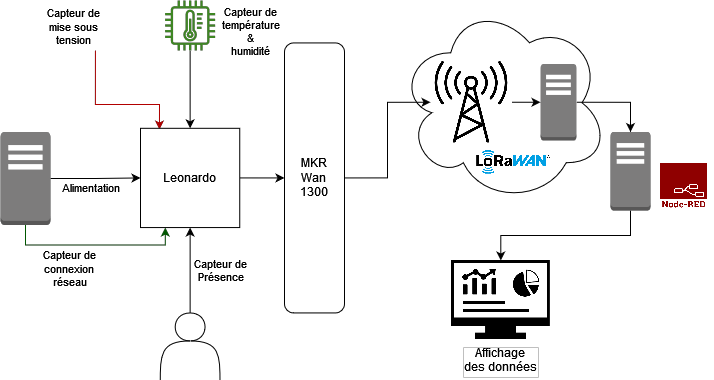Once upon a time, far far away, in a data center...
What does this project involve?
Our goal is to develop a black box capable of monitoring the performance and environmental conditions of a server or computer. This black box will be equipped with essential sensors such as temperature, humidity, presence, power supply and internet connection.
We came up with the idea for this black box following problems with the file server we use every day. We're never quite sure what's causing the problem. In fact, being able to monitor your server room accurately means determining the cause of the loss of communication as quickly as possible, and being able to act quickly.
The various sensors we have implemented enable us to measure temperature, humidity, human presence and power supply. The added bonus of this project is the use of the LoRa network, which enables us to use a different channel from the common ones, with the advantage of operating in the same way as redundancy.
How does it work?
The temperature sensor enables us to monitor temperature variations inside the server room, which is crucial to prevent overheating. The humidity sensor, meanwhile, detects humidity levels to prevent the risk of corrosion or condensation. We've also integrated a presence sensor to detect if anyone is in the vicinity of the black box, ensuring enhanced security. Finally, the power supply sensor monitors the presence of the power supply to react quickly in the event of a power cut.
To transmit this data efficiently, we chose to use the LoRa network. This long-range wireless network uses a different channel from the common ones, offering greater redundancy and reliability. What's more, it operates autonomously, which means it doesn't require a constant Internet connection.
Once collected, sensor data is sent remotely to a NodeRed server. This tool enables us to set up a dashboard with a customized visual.
A database is also deployed to collect detailed logs to store and analyze sensor feedback. The NodeRed server can then record and report abnormal behavior. This provides access to a detailed history of events that can be analyzed at a later date.
How we worked ?
To realize this project, we developed in Arduino language the different ways to collect the information sent back to us by the sensors.
It's worth mentioning that we didn't have a power supply sensor, so we used a simple USB cable which we cut and then soldered, following the datasheet available on the Internet, to adapt it to the connection on the Leonardo board. After checking that it worked properly via osiloscope, we implemented its use.
Several container tests were carried out to integrate the hardware. The very first prototype was made of cardboard, giving us an idea of what we were going to do.
We then modified a wooden box model to our liking, using laser cutting. Because of a few irregularities, we had to fine-tune it with a wood file and a drill.
Finally, for lack of time and budget, we had planned to add a shield to the Arduino Leonardo to get rid of the bulky sensor connectors.
To conclude, we search points to upgrade the project. We could use XBee or Sigfox wireless connectivity. A possibility to reactivate the equipment connected via the User Interface.












_4YUDWziWQ8.png?auto=compress%2Cformat&w=48&h=48&fit=fill&bg=ffffff)






_Ujn5WoVOOu.png?auto=compress%2Cformat&w=40&h=40&fit=fillmax&bg=fff&dpr=2)


Comments
Please log in or sign up to comment.